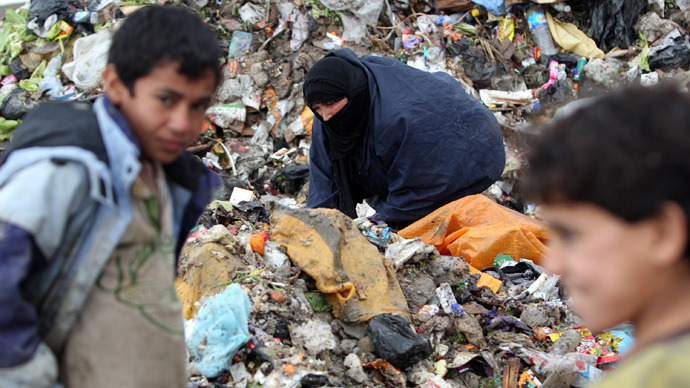‘Iraq's environmental catastrophe worse than Hiroshima’

Ten years ago, invading American troops and their allies deliberately tested all sorts of weapons, contaminating Iraqi the environment for hundreds of years to come and reducing citizens' life expectancies to 30 years, an Iraqi doctor told RT.
Over the ten years of occupation, Iraqi citizens have been developing alarmingly growing numbers of medical conditions, the Iraqi cardiologist, Dr. Omar al-Kubaisi, told RT’s Arabic-language sister channel Rusiya Al-Yaum.
RT:What is the nature of these conditions?
Dr. Omar al-Kubaisi: I’d like to start by saying thanks to the Rusiya Al Yaum TV channel for this opportunity. I would like to talk first about the general health status and then I’ll address your question about the medical conditions. The United States claimed to have been helping Iraq restore the country in all areas, such as education, through investments, but in fact the only real “help” that came from the US was their deployment of the weapons prohibited by the Geneva [Convention on the Prohibition of Military or Any Other Hostile Use of Environmental Modification Techniques] on Iraqi soil.
This convention forbids the use of any weapons capable of changing the environment at the site of war including making changes to climate and water sources, which will affect the entire ecosystem. The events of 1991 and 2003 were nothing but catastrophic. They have deployed all sorts of weapons you could think of: cluster, white phosphorus, depleted uranium munitions, toxic gases and poisonous substances, in other words chemical weapons. All these types of weapons were used deliberately and massively. They were test-tried in Iraq and caused an environmental catastrophe worse than that of Hiroshima.

RT:Isn’t it an overstatement?
OK: Not in the slightest. This is not just my opinion. You can look it up on the Internet in the reports of the Human Rights Watch and the World Health Organization. Internationally acclaimed scientists have measured the levels of radiation which were found to be indicative of radiological contamination of Iraq’s southern, central and even some northern territories. And despite all the calls for attention and help published by the Iraqi scientists – and I’d like to note that we have internationally recognized nuclear physicists and biologists in Iraq – despite all their effort no one, neither chemists, nor physicists, nor healthcare officials, nor the United States paid any attention.
Whereas these publications mentioned such things as a widespread environmental contamination resulting in a growing number of congenital deformities, miscarriages, all kinds of cancer cases, and increased levels of radiation throughout Iraq. And it wouldn’t be so bad if it were only about the US. The worst thing is that Maliki’s government and all occupation governments have been the first to crack down on those who speak about the chemical and radiological contamination.
RT:Why is that the case? Isn’t it the government’s duty to protect its people and undertake measures to eliminate contamination?
OK: I believe the government feels indebted to the occupants. All the ministers and officials are not free to talk openly about this problem. There is also a ban to publish any works or articles on this subject both here and in the United States. This ban was initiated by the US administration of the Pentagon and applies even to our scholars. But nonetheless, the information is available on the Internet, you can find publications on the contamination in Iraq and its effect on the population – and I’m not talking only about Fallujah or Basra.

There are very alarming numbers of spreading cancer cases and cases of congenital disorders. Average life expectancy of those citizens who were affected dropped by 30 years in 2010. A lethal outcome is predicted for 20% of Basra’s population. The number of breast cancer cases has grown by different assessments 15 or even 30 times. Cases of congenital heart disease have become 15 times more frequent, and cases of leukemia increased 30 times. The problem with these kind of tumors is that they can affect several different organs at a time. A person can have a brain tumor, kidney tumor and suffer from blood cancer at the same time. Another problem is that those kids who have already been exposed to radiation find it hard to handle re-irradiation. So we have a generation that has suffered losses.
RT:So we can conclude that it all has resulted in infected and damaged genes, right?
OK: No, genes of the Iraqi people are fine. However,
chemical weapons and radioactive materials did have an impact on
amino acids of the cell, which causes disorders and leads to
cumulative hereditary diseases. The half-life of radioactive
elements that were used in these weapons amounts to millions of
years. Children of the people who were exposed to radiation in
Hiroshima 50 years ago are now diagnosed with cancer and have
congenital anomalies 30 times more often than is average across the
country.
RT:So we can say that it has taken its toll on generations in Iraq?
OK: Cumulative effect lasts for hundreds of years. Air,
soil and water – all of these can become contaminated. In Iraq they
used depleted uranium weapons, and its particles remained on
damaged military hardware that was abandoned: on the surface of
tanks, cannons and motor vehicles. In a number of cases these
pieces of hardware were left in the vicinity of inhabited areas. In
case of explosion, molecules of depleted uranium are scattered,
and, as they are smaller than a micron in size, they can be easily
inhaled by a human. But once breathed in – they will stay in your
respiratory organs.

USA Today magazine published results of research carried out by the US General of the Medical Corps on chest diseases among American soldiers. The research was carried out among the soldiers of the US Navy who had filed health compensation claims. The procedure of taking tissue samples from lungs and other organs showed there were particles of depleted uranium in them.
RT:How can this tragic situation be improved?
OK: Two years ago I told you it was necessary to measure
radiation all over Iraq – back then it might cost over $60 billion.
According to some research centers, reclamation of contaminated
lands in Norway will now cost about $30-45 billion. But the amount
of such areas in Norway is around 300, while in Iraq it amounts to
thousands. Reclamation of each piece of land will cost
$100-150. You can do the math yourself. The state budget
allocation for healthcare is 5-10%. First, you have to perform the
area monitoring from the air, then you need to do the ground
monitoring with the Geiger-Mueller counters. After that, you need
to analyze soil and water to define the degree of contamination.
The next step is to produce a general plan and start treating the
soil. And this is a complex task. You either have to bury the
contaminated layers very deep in the soil or move them to special
landfills located far away from populated areas.
The statements, views and opinions expressed in this column are solely those of the author and do not necessarily represent those of RT.












